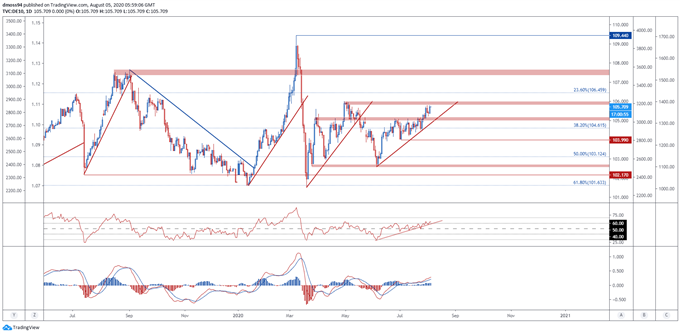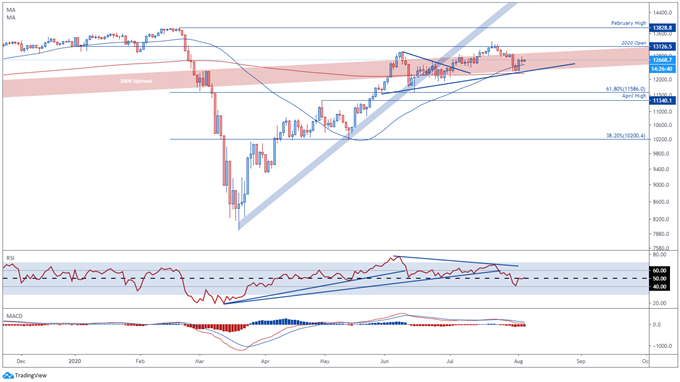DAX 30 Index, German 10-year Bunds, Covid-19 Germany – Talking Points:
- Risk-sensitive assets climbed higher during Asia-Pacific trade despite escalating tensions between the US and China.
- Covid-19 fears seem to be weighing on Germany’s DAX 30 index as it pulls back from post-crisis highs
Asia-Pacific Recap
The story of the Asia-Pacific trading session proved to be the surge seen in gold prices, as the precious metal surged to fresh yearly highs off the back of falling US Treasury yields and US Dollar weakness.
The ASX 200 tumbled below 6,000 before clawing back lost ground later in the session as Victoria, Australia’s second most populous state, recorded a record number of daily Covid-19 cases and deaths.
Risk-sensitive currencies mainly outperformed their haven-associated counterparts, as the AUD/JPY and NZD/JPY exchange rates rose alongside the trade-sensitive AUD/USD, shrugging aside the possible escalation of tensions between the US and China.
Looking ahead, retail sales and PMI data out of Europe headline the economic docket as traders being to look ahead to Friday’s non-farm payroll report.

Covid-19 Fears Weighing on Germany’s Benchmark Index
A glance across German asset classes hints at growing concern among regional investors amid a potential ‘second wave’ of coronavirus infections.
Although case numbers in Europe’s largest economy remain substantially lower than the levels seen in March, the 7-day moving average tracking daily infections jumped above 500 for the first time in over a month on July 22, notably souring investor sentiment.
In fact, the significant increase in cases seemingly coincided with the DAX 30 falling from post-crisis highs and the haven-associated German 10-year Bund climbing back above the highs from June.

VDAX, German Bunds and DAX 30 chart created using Tradingview
Furthermore, the VDAX – DAX 30 Volatility Index – bounced higher from post-crisis lows, suggesting a creeping sense of uncertainty among German equity investors.
Given the fragility of the nascent economic recovery, it stands to reason that rising cases of Covid-19 may continue to hamper the performance of regional risk assets, absent the introduction of an adequate vaccine.
With that in mind, infection numbers will be intently scrutinized over the coming weeks, as a marked increase could bring about the re-imposition of economically devastating lockdown measures and probably lead to a substantial discounting of German asset prices.
German 10-Year Bunds Daily Chart – Eyeing Push to Multi-Month Highs

German Bunds daily chart created using TradingView
The technical outlook for the German 10-year Bund hints at an extension of the uptrend from the June low (102.58), as the RSI jumps above 60 and into bullish territory.
The MACD indicator reinforces this positivity as the ‘faster’ MACD line accelerates to the topside after crossing over the ‘slower’ signal line.
However, resistance at the June high (105.99) seems to be capping buying pressure for now and may continue to do so should the RSI and MACD indicators fade from recent extremes.
To that end, a daily close above the psychologically imposing 106 level is needed to validate bullish potential and possibly signal a resurgence of risk aversion.
On the other hand, a short-term pullback to support at the 105 mark could be reflective of improving market sentiment and would probably coincide with a marked appreciation in risk-sensitive assets.
DAX 30 Index Daily Chart – 200-DMA Propping Up the German Benchmark

DAX 30 Index daily chart created using TradingView
The 200-day moving average may continue to provide a support platform for the German DAX 30 index, as buyers eye a potential push above the yearly open (13,126) to fresh post-crisis highs.
However, with the RSI flopping below 50 and the MACD indicator extending its retreat from the extremes seen in June, a surge above key resistance looks to be a step too far.
Nevertheless, the trend-defining 50-day moving average (12,492) may corral price higher after crossing over its 200-period counterpart and could drive price to retest the July high (13,315). A daily close above possibly carving a path for price to climb back towards the February high (13,829).
-- Written by Daniel Moss, Analyst for DailyFX
Follow me on Twitter @DanielGMoss

